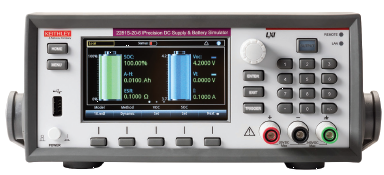

Given the increased importance of energy storage applications, last year our engineering team designed a battery simulator (the Keithley 2281S).
 |
It was designed to characterize a real rechargeable battery, then simulate it for our customers to test their products without having to use real batteries or cells. Our instrument is designed to work on many cell types including Li-ion chemistry, so I needed to make sure the charge / discharge cycle met the needs of a real test situation.
To get started, I needed to do a little research on the topic. I found the Texas Instruments “Application Report SLAA287” to be one of the most helpful. This was very useful as the TI application note showed how to build a charging circuit for Li-ion cells. They also provide source code examples on their website. I also learned that (1) discharging a Li-ion cell below 2.5 volts will result in irreversible reactions within the cell that will limit its life and (2) charging a cell in constant current mode after the cell reaches 4.2 volts results in all the energy being turned into heat and possibly rupturing the cell.
Then I obtained several 3.6 volt, 18650 type cells for my tests and verified the voltage limits from the specifications (ALWAYS review the manufacturers specification as some use different voltage and current limits). I set up our instrument to do a full discharge, then characterize the cell capacity and internal resistance during charge. I set up the experiment in our on-site laboratory with lab coat, gloves, goggles, fume hood, safety shower, and eye wash station required for this kind of test.
I also reviewed the cells’ discharge / charge protocol. My test was set up to discharge at a 1 ampere rate until the cell reached 2.5 volts. During the charge cycle, I had planned to charge at a constant current 1C rate (one times the cell mAh capacity). My cells were 1500mAh, however the manufacturer recommended a standard charge rate of 750mA (they did allow a “fast” charge of up to 4 amperes). I charged at 0.75 amperes until the cell voltage reached within 50mV of 4.2 volts. Then the charge method switched to constant voltage mode until the current dropped to about a 0.1C rate. After this charging was stopped.
The instrument I was testing was able to implement the protocol and the experiments were successful: no excess heat in the cells or any other unintended results.” We have now released the instrument. Keithley’s 2450-EC and 2460-EC potentiostats are also capable of performing charge / discharge battery testing.
Read more on the Keithley 2281S here: /node/5876
You may also find application note Number 3221 of interest: “Rechargeable Battery Charge/Discharge (Galvanic) Cycling Using the Keithley Model 2450 or Model 2460 SourceMeter® SMU Instrument”
Bill Pelster is the Director of Quality for the Keithley product line of Tektronix, Inc. He has been with the company for 37 year and has worked in engineering, applications, service, product safety, and quality. He has developed application software for testing high temperature superconductors and is now a member of the Keithley electrochemistry team. Bill holds a BEE degree from Cleveland State University (Fenn College) and an MBA from CWRU (Weatherhead School).


